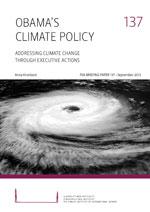President Barack Obama’s recent action to address climate change indicates that it will be one of the second term’s topical questions. The new climate change action plan introduced by Obama in June 2013 is composed of various executive actions and based on three pillars: reducing carbon pollution; leading international attempts to approach climate change; and preparing the US for the effects of climate change.
The measures already adopted on climate change provide an opportunity to examine the possibilities that the president has to implement his climate action plan through executive powers without Congress. The decision to advance the political agenda through executive decisions is at least partly attributable to the partisan gridlock currently gripping US politics.
The reach and effect of the executive decisions to address climate change outlined in the climate action plan are yet to be determined. The topical question seems to be whether the actions already taken offer hope that the US will reach its target to reduce carbon pollution and slow the effects of climate change, or whether legislative action from Congress will be called for.
Although climate change is now being addressed through executive actions that do not require new legislation from Congress, this does not rule out the possibility that legislation will be passed in the future.

